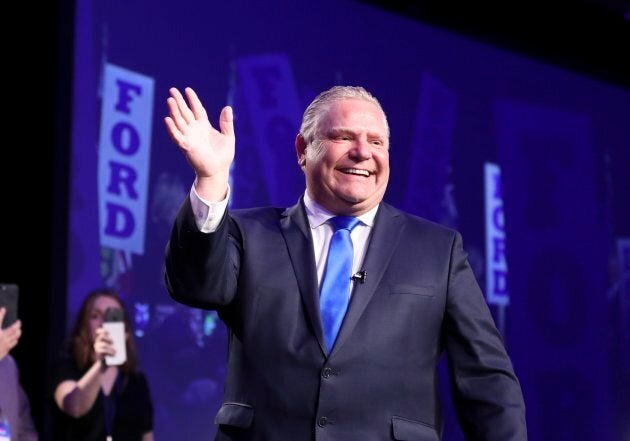
If you're a parent or expecting to become one anytime soon, Tuesday's announcement from the Ontario Liberal government likely caught your eye.
After all, Ontario Premier Kathleen Wynne's promise of free child care for preschoolers starting in 2020 is pretty enticing. But you probably have plenty of questions, too.
We spoke to an expert and delved into some data to find out what this new announcement will really mean for parents (and kids), how the new program is likely to work, and looked at its potential benefits and drawbacks.
When will the program start?
How much will it cost ?
$930 million, part of a $2.2 billion child care plan that also includes additional subsidies and expansions for children age zero to four, and the expansion of licensed child care programs in First Nations communities.
How much will this program save parents?
About $17,000 per child, according to a press release from the Office of the Premier.
Who is applicable for free daycare?
Ontario children in full-day licensed child care, from when they're age two-and-a-half until they're eligible to start kindergarten, according to the Office of the Premier.
Is it dependent on the Liberals winning the Ontario election?
Yes, it's part of the Liberals' re-election platform.
What if the Liberals don't win?

"The response from other parties seems to suggest that if they do anything, it would be something very different, either much less on the part of the Conservatives, and either different ages or more comprehensive if the NDP were to win," Queen's University Law Professor Kathleen Lahey, who is an expert on gender equality and governance, told HuffPost Canada in a phone interview.
Progressive Conservative leader Doug Ford suggested he would scrap the program if he gets elected, The Toronto Star noted. According to the PC party's 2018 election platform, their plan would introduce a refundable child care tax credit based on household income, iPolitics reported in November.
NDP leader Andrea Horwath said the plan won't actually help women return to work, noting in a press release that it only applies to one age group.
How much does daycare for preschoolers cost now?
It depends on where you live. But the highest fees for preschoolers tend to be in Ontario, and Toronto leads the pack with a median monthly fee of $1,212, according to a 2017 report from the Canadian Centre for Policy Alternatives. Mississauga ($1,052), Brampton ($1,050), Vaughan ($1,031), Markham ($1,017), London ($1,010), and Ottawa ($1,009) have the next-highest median monthly preschool fees.
Just 20 per cent of families with one child can afford licensed child care in Ontario, according to a report commissioned by the Ontario government.
What kind of daycare is applicable in this program?

"While we do respect parents' right to choose other child care arrangements that best meet their needs, funding to support free child care for preschool children will flow through municipalities to licensed child care centres and home child care agencies to homes," Wynne's spokesperson Richard Francella, told HuffPost Canada in an email interview.
"We will develop a more detailed funding approach as part of the implementation plan."
Why is the free daycare only for preschool-aged kids?
The decision to cater the program to children age two-and-a-half and older is based on a higher demand for services, The Canadian Press reported Wynne as saying.
"What we know is that it's this age group where there's the largest number of families who are looking for child care," she said. "It's the two and a half to four (year olds) ... This the age group where there's the real crunch and the bulk of people who are looking for child care that's why this is the age group we're starting with," Wynne said.
Law professor Kathleen Lahey noted that there's a unique bottleneck for child care in this age range, and called it a "well-targeted" approach. She also speculated that focusing on just one age group could make the program more palatable to voters with a more conservative view on spending.
"The question is what is the best deal they can get without the whole deal being rejected at the ballot box?" Lahey said.
"I think good governance includes being able to assess just exactly how much to move down what will be a controversial path in some quarters."
What are parents supposed to do for child care before preschool?

While there are additional subsidies and expansions for children age zero-to-four, the fact that only preschool will be free is one of the issues some have with the proposed plan.
Infant care is typically the most expensive level of daycare, followed by toddler care, according to the Canadian Centre for Policy Alternatives. The median full-time cost for infant daycare in Toronto is $21,096 per year, and $16,248 per year for toddlers.
These child care costs are a huge barrier to women's paid workforce participation, Lahey said, noting that the longer they're out of the workforce, the worse it gets. Yet, the more women who have paid work, the faster the economy grows, Lahey said. And though the proposed new program for preschoolers will certainly help, not including the 0-2.5 age range "will keep Canada at the back of the pack in the richest, most economically-competitive countries in the world," Lahey said.
"The arguments for extending this to age zero to two-and-a-half are all there. The documentation is clear. There's absolutely nothing negative that could happen if this were done. But Canada has long suffered from a very vociferous conservative attack on any form of government spending ... so there are political considerations at play here."
How will the proposed program benefit children?
"Early learning has been demonstrated to improve a child's academic performance throughout their lives," the Office of the Premier said.
"Parents will know that their children are getting the advantages of early learning and care. From a parent's perspective, that's very important, because there's a significant body of research that demonstrates that early learning care adds tremendously, measurably, to the educational abilities and literally the cognitive development of children over their lifetime," Lahey said.
Who might not benefit?

There are a number of people with difficult-to-meet child care needs, such as those working shifts at odd hours, those who work on very short notice, and those who have location issues, Lahey said.
"There are still going to be people who literally can't afford the transportation dimension of child care," Lahey said.
A number of people may also prefer family care (for instance, from an older relative), and may be resentful at having to pay taxes to pay for care they're not using, Lahey said.
Will daycares be able to meet the capacity?
"While planning for and transitioning to the new approach, the government is also providing additional funding to stabilize fees, reduce or eliminate fee subsidy waitlists and ensure the system is well positioned to transition to free preschool in September 2020," Francella said.
The Ontario government also plans to build an additional 14,000 spaces by 2023-24, Francella said.
How does Ontario's proposed program compare to other provinces?
This program will definitely improve Ontario's standing, Lahey said. But Quebec, which has had a universal child care program for more than 20 years, is "way in front of all the other provinces."
Last month, British Columbia pledged to spend an additional $1 billion on child care over the next three years to lower costs, increase the number of spaces and improve quality. Alberta's Ministry of Children's Services provides financial assistance to eligible lower-income families who use licensed care facilities. Saskatchewan's government offers subsidies for child care on a sliding scale.
Manitoba provides annual operating grants to some licensed, non-profit child-care facilities, and sets maximum fee limits for their services. In Nova Scotia, subsidies are paid directly to the licensed centre or agency that parents choose, depending on a family's income, finances and "social need."
In January, New Brunswick announced it would be offering free daycare to low-income families. Newfoundland and Labrador offers child-care subsidies for low-income families who meet a set of criteria that includes income and assets. P.E.I. offers full and partial subsidies, depending on financial and social need.
— with files from The Canadian Press